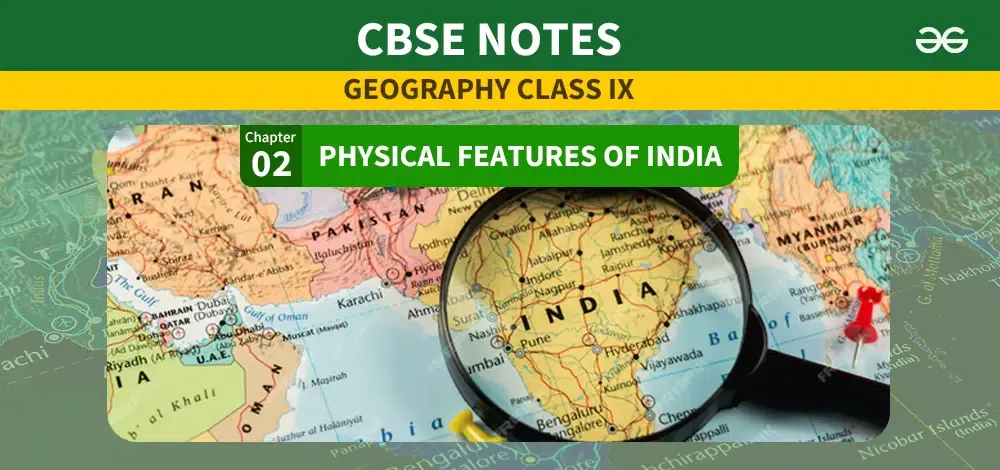
|
|
NCERT Notes Class 9 Geography: CBSE Class 9 Geography Notes are essential for students studying Social Science, as Geography is a crucial sub-subject that requires properly written answers. These notes, made by subject experts, make it easier for students to learn about how societies work and why people do what they do. By reading these notes, students can get a better grasp of how societies are organized and why people act the way they do. They are especially useful for class 9 students who want to learn more about the land.  NCERT Notes Class 9 Geography: Chapter 2: Physical Features of India IntroductionThe geographical features of India are characterized by significant diversity. Geologically, the Peninsular Plateau is one of the oldest landmasses on the planet, known for its stability over millennia. Conversely, the Himalayas and the Northern Plains represent the youngest landforms, with the Himalayan mountain range considered geologically unstable. The Himalayas exhibit a dynamic topography, boasting towering peaks, deep valleys, and swift-flowing rivers. In contrast, the Northern Plains are predominantly composed of fertile alluvial deposits. The Peninsular Plateau comprises igneous and metamorphic rocks, characterized by gently rising hills and expansive valleys, contributing to its distinct landscape. Major Physiographic DivisionsHere are the major physiographic divisions of India:
The Himalayan MountainsThe Himalayas, geologically young and structurally fold mountains, stretch over the northern borders of India, running from west to east from the Indus to the Brahmaputra. Covering about 2,400 km, they are the loftiest and one of the most rugged mountain barriers globally, with varying width and altitude. The Himalayas consist of three parallel ranges:
The Himalayas are further divided into regional divisions based on river valleys, such as the Punjab Himalayas, Kashmir Himalayas, Himachal Himalayas, Kumaon Himalayas, and Assam Himalayas. The Brahmaputra marks the eastern boundary, where the Himalayas bend southwards, forming the Purvachal or the Eastern hills and mountains. Comprising ranges like the Patkai, Naga, Manipur, and Mizo hills, these hills are mostly composed of sedimentary rocks covered with dense forests, running parallel to each other. The Peninsular PlateauThe Peninsular plateau, a tableland composed of old crystalline, igneous, and metamorphic rocks, was formed due to the breaking and drifting of the Gondwana land, making it one of the oldest landmasses. It features broad, shallow valleys and rounded hills, with two main divisions: the Central Highlands and the Deccan Plateau.
The Indian DesertThe Indian desert, located towards the western margins of the Aravali Hills, is characterized by its sandy plain covered with extensive sand dunes. This region experiences very low rainfall, below 150 mm per year, contributing to its arid climate and sparse vegetation cover. The Coastal Plains A coastal plain is a flat, low-lying piece of land adjacent to the ocean. In India, two narrow strips of plain lands are found on either side of the peninsular plateau, known as the Eastern Coastal Plain and Western Coastal Plain. Eastern Coastal Plain The Eastern Coastal Plains extend between the Eastern Ghats and the Bay of Bengal. The northern part is referred to as the Northern Circar, while the southern part is known as the Coromandel Coast. Large rivers like the Mahanadi, Godavari, Krishna, and Kaveri have formed extensive deltas along this coast. Lake Chilika is a significant feature of the Eastern Coastal Plain. Western Coastal Plain The Western Coastal Plain lies between the Western Ghats and the Arabian Sea. It consists of three sections:
The IslandsAn island is a piece of sub-continental land surrounded by water. The Lakshadweep Islands group consists of small coral islands, formerly known as Laccadive, Minicoy, and Amindive. The islands are broadly categorized into:
Located close to the equator, these islands experience an equatorial climate and are covered with thick forests. The diverse physical features of India offer immense potential for development due to the following reasons:
Related Links
Chapter 2: Physical Features of India- FAQsWhat are the major physical features of India?
What is the significance of the Himalayan Mountains?
What are the characteristics of the Indian Desert?
Describe the Coastal Plains of India.
What are the major island groups of India?
|
Reffered: https://www.geeksforgeeks.org
| Class 9 |
Type: | Geek |
Category: | Coding |
Sub Category: | Tutorial |
Uploaded by: | Admin |
Views: | 14 |